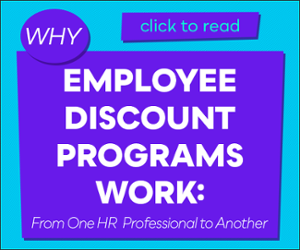Summary
- If you look at the number of businesses adopting either a full or partial WFH strategy, the paradigm has shifted in favor of more remote work, not less.
- Employers can’t ignore the WFH boost in productivity, but they’re also seeing happier employees that go beyond just the convenience of WFH.
- Employers can help managers transition to remote work by training them on how best to manage a remote team.
- HR professionals should redeploy funds meant for on-site perks like catering, swag, snacks, etc., and invest in meaningful virtual perks that can offer value and help offset inflation.
How's Your WFH Strategy?
If your business is like most businesses, you’ve experienced both some successes and also some speed-bumps as you’ve implemented your work from home (WFH) strategy.
As we see the light at the end of the pandemic tunnel, (hopefully for real this time), the decisions you make now could have a significant impact on your company’s future growth and sustainability. The consequence of getting it wrong weighs heavily on not only HR professionals but everyone in senior management as well.
Some companies simply can’t wait to get everyone back in the office again, eager to finally ditch this whole WFH situation once and for all.
Others have found value in a WFH approach and are trying to decide how they’re going to move forward, allowing some or all of their professional employees to continue working from home.
The issues are complex. It’s not just a matter of whether or not you want your employees to work remotely. Issues like employee retention, recruiting, engagement, productivity all come into play.
For senior leaders, it’s also much harder to manage and inspire your people when there’s nobody there to listen.
And then there’s the issue of maintaining some semblance of a company culture. How do you encourage meaningful social interactions between colleagues, when employees don’t bump into each other in the break room, or in the hallway, or at company events? How does management reestablish a previously healthy company culture if everyone’s gone virtual?
These are legitimate questions. Questions that we’re all struggling with. So if it’s any consolation, it’s unchartered territory that we’re all struggling to figure out.
The nice thing is, you don’t have to be stuck with your initial WFH strategy. Like any complex initiative, it should be an iterative process. There’s no reason to throw out the entire WFH policy because you’ve experienced a few hiccups along the way.
If you’re like many HR professionals, your management team is trying to figure out what your long-term WFH strategy will look like. As you grow and customize your strategy, you’re probably asking questions like: What will the hiring environment look like in six months? A year from now? Two years from now? What technologies do we lack? What policies need to be written, updated, or completely overhauled?
After digging through the latest research, I’ve noticed a few important trends that could help you formulate the best strategy for your business:
#1: WFH is fast becoming the prevailing standard for certain businesses
We’re all waiting for the official thumbs-up to return to business-as-usual, yet many companies have transitioned away from asking the “when” question, to now asking “why.” Is there a compelling reason to return to our pre-pandemic in-office work schedule?
Some leaders want to ignore the impact of the last 18+ months of working from home. But the cat is out of the bag. WFH is not going away.
Some leaders are afraid to embrace a virtual office because it simply feels safer to go back to how it was before the pandemic. But that approach also comes with some hefty risks. Employees have grown to love their WFH schedule. A recent Bloomberg study revealed that 40% of workers would consider quitting if their bosses made them return to the office full time.
The questions you should ask are: what are the risks of going completely virtual vs. adopting a hybrid schedule? How can you adapt to a virtual office and still be profitable? Is your company’s culture suited for an all virtual or hybrid schedule? What are the cost benefits of not having to pay for a physical space for your employees to work?
These questions–and countless other similar questions–have been asked and answered by some of the most iconic businesses in America. They make up a growing list of successful companies opting for an all-in, permanent work-from-home strategy. They include businesses like Twitter, Dropbox, Shopify, Atlassian, Quora, and Zillow, just to name a few.
But there is also another list of companies that have adopted a hybrid approach. That list includes companies Google, Ford, Intuit, Microsoft, Salesforce, Hubspot, and Amazon.
While these big businesses may have little in common with your company, they can at least provide some inspiration as you consider how you’ll adapt your WFH strategy.
#2: Remote workers tend to be more productive
Prior to the pandemic, the studies were mixed about whether remote workers were always more productive. A 2012 study found that, due to things like poor bandwidth, a lack of a reliable VPN, and adequate video conferencing tools, full-time workers from home were as much as 70 percent less productive than their in-office cohorts. Those companies that were successful found ways to overcome the technical challenges, but that was specific to each company and industry.
A lot has changed in the last nine years.
Not only have Zoom and Slack become verbs (“Let’s Zoom and talk about it”, or “Slack me that file.”) we’ve learned to use these and other tools a lot better.
Today, productivity during the pandemic has, at a minimum, remained stable, in many cases productivity has actually risen.
Another study shows home-based employees spend 1.4 more days working each month than a comparable in-office employee and spend 15% less time avoiding certain difficult work tasks.
Another issue relates to the amount of time wasted when working in a traditional work setting. A Bain & Company study revealed the amount of wasted time in face-to-face meetings. The average middle manager spends about 35% of their time in meetings. That percentage goes up for those higher on the corporate ladder and can reach as high as half their total workday. Of greatest concern is the fact that of all those meetings, the study estimates 37% of them are adding no value to the organization.
With hundreds of available studies on the matter, each study may look at the data a little differently. But despite those differences, both academic and business intelligence research are pretty consistent: businesses with “professional-level” employees are likely to benefit from allowing those employees to work remotely to one degree or another.
Will the trend continue over time? Will employees' emotional status eventually decline with the lack of in-person interaction?
That’s the $64,000 question. So far, the studies show it’s likely to bode well for those who WFH.
#3: Remote workers tend to be happier
Once employees have tasted the benefits of working from home they aren’t going to give it up without a fight.
A study by Psychology Today magazine BEFORE the pandemic showed remote workers are happier, feel more valued, and “overwhelmingly” believe they are more productive. Additionally, a recent Bloomberg article reports that black workers are happier when working from home, feeling more valued and treated more fairly when working from home.
Working remotely not only gives your employees more time to be with the people that matter most to them, but they’ve also enjoyed an unexpected boost to their wallets. Working from home means fewer expenses related to commuting, not to mention less wear-and-tear on their vehicle. It also means fewer out-of-pocket expenses, like buying such things as work attire, dry cleaning, eating out for lunch, etc. And let’s not forget the “necessity” of grabbing a Grande Caramel Crunch Frappuccino on the way to work. With fewer people commuting, it should come as no surprise that Starbucks took a $3 billion hit to their bottom line during the pandemic.
Another study revealed that workers gain an average of eight and a half hours per week of free time by not commuting to work. For an entire year, this adds up to over four hundred hours. Giving up that much free time amounts to a huge sacrifice to your employees.
#4: Train managers on how to trust employees
For some managers, the biggest problem with a WFH workforce means a lack of oversight of their staff. It’s especially true for bosses that don’t always trust their employees. Which is why interest in software that tracks employees' actions has jumped a whopping 600 percent during the pandemic.
But a lack of oversight doesn’t necessarily mean employees are opting to watch Netflix all day. Managers who know how to give their staff more control over their own objectives and priorities can enjoy a payoff in other significant ways.
A University of Melbourne study revealed: “Managers who encourage staff to take more control over their workflow… “(have) more competent and connected teams (and are) more motivated, engaged, (and are more) high-performing loyal employees.” Micro-managers, on the other hand, tend to see a decrease in workplace wellness, as fewer employees seem to truly flourish at work.
In other words, employees that are given the freedom to select the ways in which they’ll be most productive, typically don’t need a lot of outside motivation coming from their bosses. That’s because the career-related rewards of self-directed success is really all the motivation they need. Employees trusted to be self-directed tend to be more productive, have less burnout, and are less likely to look for work elsewhere.
But transitioning to this self-directed approach may require training for some managers. They not only need to learn how to avoid micro-managing their team, but also how to communicate effectively in a remote environment. This “less-is-more” management style is not always intuitive and can require some training. But the payoff in productivity is likely to be well worth the investment. Not to mention have a positive impact on employee retention.
#5: Replace suspended on-site employee perks with virtual perks
On-site perks come in many shapes and sizes. From ping-pong and foosball, to catered lunches, yoga, and healthy snacks, these on-site perks serve a purpose when employees are spending their workweek in the office.
But with fewer people in the office, many of these perks have been suspended.
Why not re-deploy the budget for these suspended employee perks, into meaningful virtual perks instead?
One type of digitally delivered perks includes a subscription to Spotify or Headspace.
Many employees listen to music during their focus time, and a subscription to Spotify can be an addicting benefit with a lot of usage.
Headspace is a meditation app that can help your employees manage stress, and learn how to focus on what’s important. A free subscription can lead to greater employee mental health and stress reduction.
Among the most popular of all virtual employee perks programs that can benefit nearly all your employees, is a quality employee discount program. (Like Access Perks.)
With inflation rates at historic highs, an employee discount program can deliver meaningful, everyday savings that can help take away some of the sting that comes from higher consumer prices. As all your employees are consumers, no one wants to pay full price when they don’t have to. The most popular employee discount program, according to HR directors, can offer employees meaningful savings and help you drive ongoing engagement.
Beware that some discount programs aren't all they're cracked up to be. Some only offer discounts exclusively on things like event tickets. Other programs focus completely on less-than-inspiring online-only discounts, or they focus on occasional purchases such as spa treatments, jiu-jitsu classes, or tax preparation.
The best employee discount programs will offer a well-rounded selection of discounts on everyday purchases, like local restaurants, popular big-box stores, Disney and Universal Studios theme park tickets, groceries, auto service centers, home and garden suppliers, hotels, car rentals, airfare, etc.
For the cost of an onsite catered lunch, you can give your employees an entire year of mobile coupons that could save them hundreds of dollars. If you’d like to learn how to identify and assess employee discount programs, check out this free guide to employee discount programs.
It's coming fast
The end to the pandemic is coming. Maybe not as quickly as we all would like it to happen, but it is coming. How well your company has adapted your WFH strategy could give your business a significant competitive advantage. With inflation pressures eating away at earnings, and no end in sight to the red-hot war for talent, HR directors and senior managers are faced with some critical decisions. But when you're empowered with good information and rigorous data, those decisions should be a lot easier to make.






